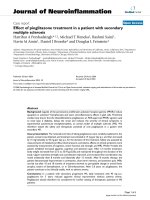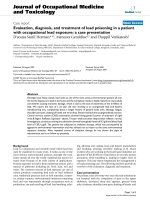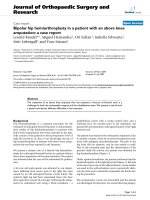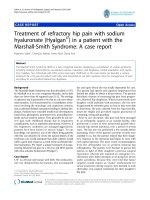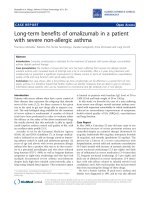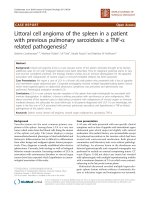An uncommon manifestation of paraneoplastic cerebellar degeneration in a patient with high grade urothelial, carcinoma with squamous differentiation: A case report and literature review
Bạn đang xem bản rút gọn của tài liệu. Xem và tải ngay bản đầy đủ của tài liệu tại đây (1.38 MB, 7 trang )
Zhu et al. BMC Cancer (2016) 16:324
DOI 10.1186/s12885-016-2349-3
CASE REPORT
Open Access
An uncommon manifestation of
paraneoplastic cerebellar degeneration
in a patient with high grade urothelial,
carcinoma with squamous differentiation:
A case report and literature review
Yaofeng Zhu1†, Shouzhen Chen1†, Songyu Chen2, Jing Song3, Fan Chen1, Hu Guo1, Zhenhua Shang1, Yong Wang1,
Changkuo Zhou1 and Benkang Shi1*
Abstract
Background: Paraneoplastic neurological syndromes (PNS) are rare disorders associated with malignant tumours,
which are triggered by autoimmune reactions. Paraneoplastic cerebellar degeneration (PCD) is the PNS type most
commonly associated with ovarian and breast cancer. Two bladder cancers manifesting in PCD were previously
reported. However, the cancers in these cases had poor outcomes.
Case presentation: Here, we present a 68-year old man with history of high-grade papillary urothelial carcinoma of
the bladder. The patient suffered from persistent cerebellar ataxia accompanied by bladder cancer recurrence five
months after transurethral resection of the bladder tumour (TURBt). Laboratory screening for the specific antibodies
of paraneoplastic neurological syndromes revealed no positive results. Symptoms were not remitted after a
7-day-course of high-dose glucocorticoid therapy. To our surprise, the patient recovered fully after laparoscopic
radical cystectomy. Postoperative pathology revealed that surgical specimens were urothelial carcinoma in situ (CIS)
and squamous cell carcinoma of the bladder. The patient remained asymptomatic and there was no evidence of
recurrence after the followup period of 11 months.
Conclusion: To our knowledge, this is the third report of PCD in a patient with bladder cancer. This case showed
that tumour resection cured the PCD. To assist clinical evaluation and management, literature regarding basic PNS
characteristics and bladder cancers was reviewed.
Keywords: Paraneoplastic cerebellar degeneration, Bladder cancer, High grade urothelial, Carcinoma, Squamous
differentiation
Background
The bladder cancer is the 11th most common site of
cancer diagnosis and the 14th leading cause of cancerrelated deaths in the world [1]. The 2004 WHO/ISUP
system classifies papillary urothelial neoplasms into four
types: papilloma, papillary urothelial neoplasm of low
* Correspondence:
†
Equal contributors
1
Department of Urology, Qilu Hospital of Shandong University, Wenhua Xi
Road, Jinan, Shandong Province, People’s Republic of China
Full list of author information is available at the end of the article
malignant potential, low-grade papillary urothelial carcinoma, and high-grade papillary urothelial carcinoma
[2]. The high-grade papillary urothelial carcinoma was
associated with the high recurrence rate. The main clinical treatment for non-muscle-invasive bladder cancer is
transurethral resection of Ta and T1 bladder tumours
[3]. However, carcinoma in situ (CIS) is a high-grade,
flat, non-invasive urothelial form. This carcinoma is
often multifocal and progresses to muscle-invasive disease. Therefore, endoscopic procedures alone are insufficient for CIS treatment. Either intravesical bacillus
© 2016 Zhu et al. Open Access This article is distributed under the terms of the Creative Commons Attribution 4.0
International License ( which permits unrestricted use, distribution, and
reproduction in any medium, provided you give appropriate credit to the original author(s) and the source, provide a link to
the Creative Commons license, and indicate if changes were made. The Creative Commons Public Domain Dedication waiver
( applies to the data made available in this article, unless otherwise stated.
Zhu et al. BMC Cancer (2016) 16:324
Calmette-Guérin (BCG) instillations or radical cystectomies (RC) are applied [4, 5]. Several studies have revealed
excellent outcomes after immediate RC for CIS [6].
Paraneoplastic neurological syndromes (PNS) are rare
disorders associated with malignant tumours that are not
directly caused by tumour invasion and metastasis. The
autoimmune response is elicited by the ectopic expression
of neural antigens in neoplastic tissues, which eventually
attack the nervous system of PNS patients [7]. PNS incidence is estimated to be 0.5–1 %, varying by cancer type
[8, 9]. Paraneoplastic cerebellar degeneration (PCD) is the
type of PNS most commonly associated with ovarian and
breast cancer [9]. PCD is characterized by subacute cerebellar ataxia within 12 weeks and subsequent cerebellar
atrophy [10]. Bladder cancers presenting with PCD have
rarely been reported. Greenlee JE [11] and Tetsuka S [12]
reported PCD and its causal antibody in bladder cancer
patients. Here, we discuss a patient with urothelial CIS of
the bladder who suffered from PCD. Unlike two previous
cases, we found no specific antibody causing PCD. Literature concerning unusual cases are reviewed.
Case presentation
A 68-year-old man was admitted to the Qilu Hospital
of Shandong University on November 17, 2014 for
urinary irritation, dysuria and haematuria. The patient’s
condition was good, and weight loss, night sweats and
recent fever did not present. Urinalysis showed red and
white blood cell counts of 61.4/μL and 313.8/μL, respectively. Cystoscopy showed scattered cauliflower-like
neoplasms located at 11°-1° of the narrow bladder neck,
with a maximum diameter of 1.5 cm. A biopsy was then
conducted and the pathological examination revealed
that the neoplasms were high-grade papillary urothelial
carcinoma of the bladder. CT scanning showed a thickened anterior bladder wall, without enlarged pelvic
lymph nodes. Transurethral resection of the bladder
tumour (TURBt) was conducted after a definitive diagnosis was made. Several villous tumours were found on
the neck of the bladder during the operation. The postoperative pathological examination showed that the
surgical specimens were high-grade papillary urothelial
carcinoma accompanied by differentiated squamous cell
carcinoma. This carcinoma also involved the prostate.
Haematuria and dysuria symptoms disappeared after
TURBt. Therefore, the patient’s family refused further
treatment and the patient was discharged.
The patient was referred to our hospital again on
March 27, 2015 because of vomiting, progressive gait
imbalance and Haematuria for the previous five days.
Neurological examinations revealed ataxic gait and bilateral coarse nystagmus. Slight dysmetria was confirmed by
finger-to-nose and heel-knee-shin testing. Haematuria led
to the performance of a urinalysis showing red and white
Page 2 of 7
blood cell counts of 554/μL and 6748/μL, respectively.
Further cystoscopy revealed that bladder mucosa located
at 11°-1° of the bladder neck suffered hyperaemia, edema,
and erosion of the asperous surface. The biopsy showed a
high-grade papillary urothelial carcinoma and squamous
differentiation.
Further laboratory and radiographic evaluations were
conducted to clarify the relationship between bladder
cancer recurrence and emerging cerebellar ataxia. A
brain MRI was performed to exclude brain metastases
from bladder cancer (Fig. 1 c, d). The MRI revealed no
obvious morphological change of the cerebellum (Fig. 1
a, b). The abdominal and pelvic CT scans revealed that
the bladder wall was thickened, especially at the neck
(Fig. 2). The above radiographic findings suggest little
possibility exists that nervous symptoms were triggered
by brain metastases from bladder cancer.
Further laboratory examinations were conducted to
validate the cause of neurological symptoms. Nine common types of paraneoplastic antibodies were all negative
in the serum and cerebrospinal fluid (CSF). Details of
the paraneoplastic antibodies are shown in Table 1. The
CSF examination revealed an elevated level of protein
(58.6 mg/dl, normal: 15–45 mg/dl), IgG (39.5 mg/L,
normal < 34 mg/L), and albumin (391 mg/L, normal <
350 mg/L). Pandy's test of CSF was positive, while CSF
cell counts were normal. Tumour markers showed that
squamous cell cancer antigen (SCC) and non-small cell
lung cancer antigen (CYFRA21-1) serum concentrations were elevated (SCC: 6 ng/ml, normal: 0.1–0.3 ng/
ml; CYFRA21-1: 3.5 ng/ml, normal < 1.5 ng/ml). The
thyroglobulin serum concentration was low (<0.04 ng/ml,
normal: 1.4-78 ng/ml). The examination of rheumatic
antigens revealed no positive results. The electroencephalogram revealed no epileptogenic activity.
Based on these findings, we suspected that the patient
suffered from PCD. The patient initially received a 5-day
course of methylprednisolone (500 mg intravenously daily)
without significant clinical improvement. Considering the
first postoperative pathological examination revealed the
bladder cancer involved the prostate and recurred, the patient underwent laparoscopic radical cystectomy (LRC).
The postoperative pathological examination revealed that
the surgically removed bladder was urothelial CIS and
well-differentiated squamous cell carcinoma (Fig. 3). This
finding was in accordance with the changes in serum SCC
and CYFRA21-1. The squamous cell carcinoma was dispersed in the bladder mucosa (Fig. 3a) and accounted for
approximately 5 % of all carcinomas. Neurological symptoms disappeared, and basic daily living activities were
obviously improved, according to Barthel score (Table 2),
after LRC. The patient remained asymptomatic and there
was no evidence of recurrence after the followup period of
11 months.
Zhu et al. BMC Cancer (2016) 16:324
Page 3 of 7
Fig. 1 Magnetic resonance imaging (MRI) of the brain. a and b, the T2WI sagittal scan showed no obvious morphological change of the cerebellum;
c and d, the enhanced-scanning MRI revealed no sign of brain metastases from bladder cancer
Discussion
PNS was initially defined as the presence of cancer and
the exclusion of other known causes of the neurological
symptoms. Examples of such causes include metastasis,
coagulopathy, infections, metabolic or nutritional disturbances, and treatment-induced neurotoxicity [10, 13].
The exact pathogenesis of most PNS is unknown. However, neuronal antigens expressed by cancers could activate the immune system. Moreover, many antineuronal
antibodies generated by the activated immune system
attack the nervous system [7]. Antineuronal antibodies
can affect different nervous system regions, and multiple
clinical manifestations can present in PNS. When the
cerebellum is affected, the rapid development of severe
cerebellar ataxia is caused by extensive Purkinje neurons
loss, defined as PCD.
According to the PNS Euronetwork recommended
diagnostic framework in 2004 [13], the following criteria
are required to define PCD: (1) severe pancerebellar syndrome developing in less than 12 weeks; (2) no radiographic evidence of cerebellar atrophy other than that
expected by the patient’s age; and (3) the significant
interference of symptoms caused by PCD with basic
activities of daily living. Neurological syndromes developed in five days and the MR examnation excluded cerebellar atrophy in the present case. The Barthel activities
of daily living Index was 35 after the onset of the disease,
indicating a severe effect. All the characteristics in the
Fig. 2 Computed tomography (CT) of the abdomen and pelvis. A, the bladder wall was thickened; B, the neck of bladder was thicker than the
bladder wall
Zhu et al. BMC Cancer (2016) 16:324
Page 4 of 7
Table 1 Examination Results of Paraneoplastic Antibodies
Table 2 Barthel Index of Activities of Daily Living Before and
After LRC
Type of antibodies: Ig G
Antibody Description
Results
Activities
Independent Needs help Unable Before LRC After LRC
Anti-Amphiphysin
(−)
Feeding
10
5
0
5
10
Anti-CV2.1
(−)
Transfer
15
5 or 10
0
0
10
Anti-PNMA2/Ta
(−)
Grooming
5
0
/
0
5
Anti-Ri
(−)
Toilet use
10
5
0
5
10
Anti-Yo
(−)
Bathing
5
0
/
0
5
Anti-Hu
(−)
Dressing
10
5
0
5
10
Anti-Recoverin
(−)
Mobility
15
5 or 10
0
0
10
Anti-SOX1
(−)
Stairs
10
5
0
0
5
Anti-Titin
(−)
Bowels
10
5
0
10
10
Bladder
10
5
0
10
10
35
85
(−) = negative
Total Score 100
present case met PCD diagnostic criteria. Other possible
reasons for neurological syndromes were excluded. The
neurological syndromes associated with bladder cancer
could be clinically diagnosed as PCD.
PNS is commonly associated with ovarian cancer,
breast cancer, SCLC, or Hodgkin’s disease. Few reports
have associated PNS with bladder cancer. We retrospectively reviewed English literature regarding PNS
and bladder cancers. We used PubMed, Medscape and
EMBASE to search for studies on this topic, yielding
eight articles. Only two reported a relationship between
PCD and bladder cancer. Therefore, this study is the third
to describe the relationship between PCD and bladder
cancer. Clinical and pathological features were summarized according to previous reports and the present case
(Table 3).
The male to female ratio of 2 to 1 in the nine related
cases is different from the bladder cancer incidence rate.
The worldwide incidence rate is believed to be 8.9/
100,000 and 2.2/100,000 for men and women, respectively. Therefore, the male to female ratio is more than 4
to 1 [1]. Sean et al. reported that the female to male
ratio of 34 PNS patients seropositive for anti-Ri was 2 to
1 [14]. British data showed a striking female preponderance of PNS, with a female to male ratio of 2.3 to 1 [15].
Therefore, the female patients with bladder cancer may
be predisposed to PNS. This finding is the same as for
PNS caused by other cancers.
PNS is caused by high-grade muscle-invasive bladder
cancer in most cases. Blood supplies of the muscleinvasive bladder cancer are richer, facilitating the circulation of neuronal antigens expressed by high-grade cancers. In the present case, the patient with the urothelial
CIS and squamous cell carcinoma of the bladder suffered from PCD. Matsumoto L. reported that CIS of the
testis triggered severe hypokinesis as a paraneoplastic
manifestation and detection of anti-Ma2 antibodies [16].
In this case, the bladder cancers comprised high-grade
urothelial carcinoma and well-differentiated squamous cell
carcinoma. However, methods of verifying which type of
carcinoma causing PCD are limited. Gita reported that recurrent bladder cancers with squamous features caused
paraneoplastic encephalomyelitis [17]. Numerous reports
of other organs have also demonstrated that PNS was
caused by squamous cell carcinoma [18, 19]. Therefore,
Fig. 3 HE staining of bladder cancer tissues. a, HE staining showed irregular squamous cell carcinoma dispersed in the bladder mucosa. b, HE
staining showed the urothelial CIS
Zhu et al. BMC Cancer (2016) 16:324
Table 3 Clinical and Pathological Features in Nine Cases of Bladder Cancer with PNS
Case No.
Author
Year
Age/Gender Stage Pathology
Clinical syndromes
Antibody Treatment
Prognosis
1
Gita et al.[17]
2015
73/F
Ma
Poorly differentiated carcinoma with
squamous features
PEM
Negtive
Partial improvement
2
Syuichi et al.[12]
2013
66/M
N/A
Urothelial carcinoma
PCD
Anti-CKB TURBT
No improvement
Surgical resection and
immunosuppression
3
Lukacs et al.[20]
2012
76/F
pTa
Urothelial carcinoma
PEM and SSN
Anti-Hu
TURBT
Partial improvement
4
Forte et al.[21]
2009
76/M
pT2
High grade urothelial carcinoma
Neuromyotonia
AntiVGKC
Resectionofthetumour
Complete improvement
5
Sean et al.[14]
2003
59/M
N/A
N/A
POM
Anti-Ri
N/A
N/A
6
Charles et al.[22]
2001
57/M
pT3
High grade urothelial carcinoma
POM
Anti-Ri
Radical cystectomy and
immunosuppression
Partial improvement
7
Lowe et al.[23]
1992
71/M
pT3
High grade urothelial carcinoma
Visual changes,
glossal spasm and
dysphagia
N/A
Combination
chemotherapy
Complete improvement
8
John et al.[11]
1999
64/F
pT2
High grade urothelial carcinoma
PCD
Anti-Yo
Partial resection of the
bladder
No improvement
9
Current report
2015
68/M
pCIS
High grade urothelial carcinoma and the PCD
well-differentiated squamous cell
carcinoma
Negtive
Laparoscopic radical
cystectomy
Complete improvement
A recurrent pelvis mass proven as urothelial carcinoma 22 years after radical cystectomy; PEM Paraneoplastic encephalomyelitis; PCD Paraneoplastic cerebellar degeneration; SSN Subacute sensory neuronopathy; POM
Paraneoplastic opsoclonus-myoclonus; Anti-CKB anti-creatine kinase, brain-type; N/A Not available
a
Page 5 of 7
Zhu et al. BMC Cancer (2016) 16:324
we believe the PNS is more likely to arise in patients
with high grade urothelial carcinoma with squamous
differentiation.
Onconeural antibodies are of vital importance in PNS
pathogenesis and diagnosis. However, only 60–70 % of
patients have detectable onconeural antibodies [10].
Onconeural antibodies were not detected in the present
case. Table 3 shows that the bladder cancer antibodies
inducing PNS are anti-Ri, anti-Hu, anti-Yo and antiVGKC. SCC and CYFRA21-1 serum concentrations
were increased. SCC and CYFRA21-1 are squamous cell
carcinoma markers and not paraneoplastic antibodies.
No relationship between the low serum thyroglobulin
level and PCD is believed to exist. The low serum thyroglobulin level may be due to primary thyroid changes.
Early treatment of the related tumour is the best way
to promote neurological improvement. The therapeutic
effects of immune therapy were unsatisfactory in these
nine cases. The underlying bladder cancer received early
diagnosis and timely radical cystectomy. Therefore, injury to the nervous systems was reversible, and PNS
disappeared in the present case. Thus, patients with
muscle-invasive bladder cancer or CIS of the bladder
that simultaneously suffered from PNS require timely
radical cystectomy to avoid irreversible injury to the
nervous system.
Conclusion
The patient in the present case suffering from PCD
attained a good prognosis. This prognosis was due to
early diagnosis and timely radical cystectomy. PNS has
an obvious female preponderance in patients with bladder cancers. PNS is more likely to arise in patients with
high grade urothelial carcinoma with squamous differentiation. Therefore, timely radical cystectomy is necessary to achieve a good prognosis.
Ethics approval and consent to participate
The study was approved by the Ethics Committee of Qilu
Hospital of Shandong University and the methods were
carried out in accordance with the approved guidelines.
Consent for publication
Written informed consent was obtained from the patient
for publication of this case report and any accompanying
images. A copy of the written consent is available for review by the Editor of this journal.
Abbreviations
PNS: paraneoplastic neurological syndromes; PCD: paraneoplastic cerebellar
degeneration; TURBt: transurethral resection of bladder tumor;
CIS: Carcinoma in situ; BCG: Bacillus Calmette-Guérin; RC: radical cystectomies;
CSF: cerebrospinal fluid; MRI: magnetic resonance imaging; CT: computed
tomography.
Page 6 of 7
Competing interests
The authors declare that they have no competing interest.
Authors’ contributions
YZ and SZC collected the clinical data and drafted the manuscript. SYC
and JS revised the manuscript. FC, HG, ZS and YW carried out the clinical
management of the patient. CZ carried out the pathological diagnosis and
immunohistochemical staining. BS designed the manuscript and tables. All
authors have read and approved the manuscript.
Acknowledgements
We would like to thank the clinical pathologists Prof. Bo Han, Prof. Jianping
Zhang and Dr. Wei Gao for kindly helping us with the histopathologic
evaluation.
Funding
This work was supported by the Tai Shan Scholar Foundation to B. Shi,
Science Foundation of Qilu Hospital of Shandong University (Grant
2015QLMS28 to B. Shi; Grant 2015QLQN21 to Y. Zhu), Medicine and Health
Science Technology Development Project of Shandong Province (Grant
2014WS0138 to Y. Zhu; Grant 2014WS0144 to C. Zhou).
Author details
1
Department of Urology, Qilu Hospital of Shandong University, Wenhua Xi
Road, Jinan, Shandong Province, People’s Republic of China. 2Department of
Neurosurgery, Shanghai tenth people’s Hospital, Tongji University, Yanchang
Zhong Road, Shanghai, People’s Republic of China. 3Shandong University
School of Medicine, Wenhua Xi Road, Jinan, Shandong Province, People’s
Republic of China.
Received: 15 June 2015 Accepted: 11 May 2016
References
1. Chavan S, Bray F, Lortet-Tieulent J, Goodman M, Jemal A. International
variations in bladder cancer incidence and mortality. Eur Urol. 2014;66(1):59–73.
2. Miyamoto H, Miller JS, Fajardo DA, Lee TK, Netto GJ, Epstein JI. Non-invasive
papillary urothelial neoplasms: the 2004 WHO/ISUP classification system.
Pathol Int. 2010;60(1):1–8.
3. Richterstetter M, Wullich B, Amann K, Haeberle L, Engehausen DG, Goebell
PJ, Krause FS. The value of extended transurethral resection of bladder
tumour (TURBT) in the treatment of bladder cancer. BJU Int. 2012;110(2 Pt
2):E76–79.
4. Griffiths TR, Charlton M, Neal DE, Powell PH. Treatment of carcinoma in situ
with intravesical bacillus Calmette-Guerin without maintenance. J Urol.
2002;167(6):2408–12.
5. Takenaka A, Yamada Y, Miyake H, Hara I, Fujisawa M. Clinical outcomes of
bacillus Calmette-Guerin instillation therapy for carcinoma in situ of urinary
bladder. Int J Urology. 2008;15(4):309–13.
6. Lamm DL. Carcinoma in situ. Urol Clini North Am. 1992;19(3):499–508.
7. Darnell RB, Posner JB. Paraneoplastic syndromes involving the nervous
system. N Engl J Med. 2003;349(16):1543–54.
8. Rosenfeld MR, Dalmau J. Diagnosis and management of paraneoplastic
neurologic disorders. Curr Treat Options Oncol. 2013;14(4):528–38.
9. Giometto B, Grisold W, Vitaliani R, Graus F, Honnorat J, Bertolini G,
Euronetwork PNS. Paraneoplastic neurologic syndrome in the PNS
Euronetwork database: a European study from 20 centers. Arch Neurol.
2010;67(3):330–5.
10. Kannoth S. Paraneoplastic neurologic syndrome: A practical approach. Ann
Indian Acad Neurol. 2012;15(1):6–12.
11. Greenlee JE, Dalmau J, Lyons T, Clawson S, Smith RH, Pirch HR. Association
of anti-Yo (type I) antibody with paraneoplastic cerebellar degeneration in
the setting of transitional cell carcinoma of the bladder: detection of Yo
antigen in tumor tissue and fall in antibody titers following tumor removal.
Ann Neurol. 1999;45(6):805–9.
12. Tetsuka S, Tominaga K, Ohta E, Kuroiwa K, Sakashita E, Kasashima K,
Hamamoto T, Namekawa M, Morita M, Natsui S, et al. Paraneoplastic
cerebellar degeneration associated with an onconeural antibody against
creatine kinase, brain-type. J Neurol Sci. 2013;335(1–2):48–57.
13. Graus F, Delattre JY, Antoine JC, Dalmau J, Giometto B, Grisold W, Honnorat
J, Smitt PS, Vedeler C, Verschuuren JJ, et al. Recommended diagnostic
Zhu et al. BMC Cancer (2016) 16:324
14.
15.
16.
17.
18.
19.
20.
21.
22.
23.
Page 7 of 7
criteria for paraneoplastic neurological syndromes. J Neurol Neurosurg
Psychiatry. 2004;75(8):1135–40.
Pittock SJ, Lucchinetti CF, Lennon VA. Anti-neuronal nuclear autoantibody
type 2: paraneoplastic accompaniments. Ann Neurol. 2003;53(5):580–7.
Candler PM, Hart PE, Barnett M, Weil R, Rees JH. A follow up study of
patients with paraneoplastic neurological disease in the United Kingdom. J
Neurol Neurosurg Psychiatry. 2004;75(10):1411–5.
Matsumoto L, Yamamoto T, Higashihara M, Sugimoto I, Kowa H, Shibahara
J, Nakamura K, Shimizu J, Ugawa Y, Goto J et al. Severe hypokinesis caused
by paraneoplastic anti-Ma2 encephalitis associated with bilateral intratubular
germ-cell neoplasm of the testes. Mov Disord. 2007;22(5):728–31.
Thanarajasingam G, Milone M, Kohli M: Paraneoplastic encephalopathy: an
unusual presenting feature of bladder cancer metastasis. BMJ Case Rep. 2015;
2015. doi:10.1136/bcr-2014-208913.
Dai Y, Li P, Yan S, Xia X, Li Z, Xia M: Lung squamous carcinoma with two
paraneoplastic syndromes: dermatomyositis and Lambert-Eaton myasthenic
syndrome. Clinical Respir J 2014
Bruylant K, Crols R, Humbel RL, Appel B, De Deyn PP. Probably anti-Tr
associated paraneoplastic cerebellar degeneration as initial presentation
of a squamous cell carcinoma of the lung. Clin Neurol Neurosurg. 2006;
108(4):415–7.
Lukacs S, Szabo N, Woodhams S. Rare association of anti-hu antibody
positive paraneoplastic neurological syndrome and transitional cell bladder
carcinoma. Case Rep Urol. 2012;2012:724940.
Forte F, Pretegiani E, Battisti C, Sicurelli F, Federico A. Neuromyotonia as
paraneoplastic manifestation of bladder carcinoma. J Neurol Sci. 2009;
280(1–2):111–2.
Prestigiacomo CJ, Balmaceda C, Dalmau J. Anti-Ri-associated paraneoplastic
opsoclonus-ataxia syndrome in a man with transitional cell carcinoma.
Cancer. 2001;91(8):1423–8.
Lowe BA, Mershon C, Mangalik A. Paraneoplastic neurological syndrome in
transitional cell carcinoma of the bladder. J Urol. 1992;147(2):462–4.
Submit your next manuscript to BioMed Central
and we will help you at every step:
• We accept pre-submission inquiries
• Our selector tool helps you to find the most relevant journal
• We provide round the clock customer support
• Convenient online submission
• Thorough peer review
• Inclusion in PubMed and all major indexing services
• Maximum visibility for your research
Submit your manuscript at
www.biomedcentral.com/submit
